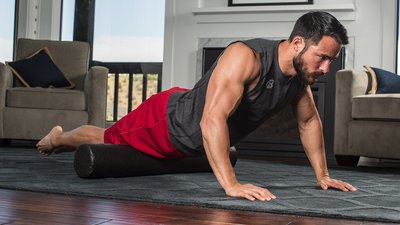Over the course of the past decade, foam rollers have gone from being a rare and obscure tool, to something you wouldn't be surprised to find in your grandma's closet. Three-foot foam tubes—and too many trigger point balls and other torture devices to count—are in every gym, and for sale in every sporting goods store, and even in most supermarkets.
But with this widespread popularity comes the hard swing of the pendulum. More people are now foam rolling than ever before, and fewer of them have the slightest idea how, when, or why to use this object to make their bodies feel and function better.
I'm not going to tell you to throw your foam roller in the trash or heave that lacrosse ball out a window, just have a plan when you use them—this plan! Here's how to get the very most out of your rolling for specific goals, and waste the least amount of your time.
Pre-Training: Hit Your "Lynchpin of Dysfunction"
When implementing foam rolling into a pre-training warm-up routine, you must ask yourself the question, "What goal am I looking to achieve with the use of the roller?"
Most lifters and athletes will answer a combination between attempting to alleviate minor aches and pains and improving their mobility before jumping into the big lifts of the day. Both are good goals, and both can be achieved through the use of neuromuscular trigger point (NMTP) techniques on the foam roller or other mobility device.
Trigger-point work taps into the power of the central and peripheral nervous system's ability to make rapid changes in the quality of muscular tissues, and sometimes can actually work to alleviate chronic pain in the process. No, it's probably not a question of scar tissue or adhesions, it's a neurological phenomenon, and that's why it can result in incredibly quick, positive changes.
The key is to pick the right areas to target. Concentrate on key areas of chronic tightness such as the hip flexors, chest, and posterior shoulder and work to find "hot spots" of pain there.
Once you land on a hot spot—you'll know when you do—place the roller directly over the area and oscillate on and off of this trigger point for 15-30 seconds, using smooth motions and constant pressure, moving with only 1-2 inches of relative motion of your body over the roller.
Prioritize the biggest limiting factor for pain or movement dysfunction, and concentrate all your pre-training foam rolling over this key area, which I term the "lynchpin of dysfunction." When done before strength training, and executed pristinely, you can experience immediate improvements in both pain and movement quality that will translate to better training in the short term.
During Training: Mobility Supersets
Trigger-point work shows the power of the neuromuscular system and its adaptability. But it has a weakness: the long-term effects of these techniques can be very limited. This shouldn't be surprising, though. After all, it took you months or years to develop that pain, right?
Because the pain reduction and mobility gains you make from trigger point work is finite, you shouldn't trust that pre-workout work is enough to give you a full hour or so of high-quality, pain-free movement. Strategically utilizing supersets which incorporate low-intensity foam rolling is an effective and efficient way to get the most out of your power, strength, or hypertrophy movements under load while battling through limitations.
To be clear, this shouldn't be complicated. Adding in 15-20 seconds of concentrated foam rolling on targeted weak links before executing sets of that exact movement pattern is sufficient to facilitate more quality work.
Two key areas which this intra-set mobility modulation foam rolling works extremely well with is the quadriceps during squatting, and the pectoralis group during horizontal or vertical pressing. Program the foam rolling technique first in the superset block, followed directly by the loaded movement being trained. Here's how it will look on the bench press, for example:
- A1: Foam roll pectoralis group 4 sets of 15 sec., rest 15 sec.
- A2: Barbell bench press 4 sets of 5 reps, rest 90 sec.
This type of rolling should feel a little different—and a little less intense—than your pre-workout routine. Since you should want to preserve concentration and energy for the big lift, ensure your body is relaxed and passive, and don't put too much pressure down on the roller. I recommend placing your body on top of the roller, and then "pinning" the key muscle under the roller. Roll and stretch over the roller, creating a "slide and glide" sensation in the tissues you're targeting.
The goal isn't to unlock anything that's locked here; it's simply to remind those key muscles to maintain their function, before you go display in the lift. It's not complicated, but it can be very effective.
Post-Workout: Tune Down and Heal Up
After a training session is through, it's time to shift your overall approach from performance to recovery. Nutrition and hydration become more important here, but foam rolling can also help spark the regeneration process before an athlete ever leaves the gym.
The basics of this approach are similar to the pre- and intra-workout methods, but the execution is slightly different. This is when you make those broader passes that people associate with the term "foam rolling," and specifically, you do it to the muscles you just worked.
The larger superficial musculature of the body such as the quadriceps, glutes, hamstrings, pectorals and lats have huge amounts of blood supply and neurological innervation due to their expansive surface area and relative thickness. This means they provide the biggest bang for your buck in also stimulating a parasympathetic "rest and recovery" response in the central nervous system.
Using slow passes between 6-12 inches or relative motion and extending a rolling session out to 5-10 minutes following training, we can help bring down vital metrics such as heart rate, blood pressure, and respiratory rate, while also improving the blood flow in the tissues that were just worked.
This is the most common type of foam rolling you'll see in the gym setting, but simply switching the time you do it, from the beginning of a workout to the end, dovetails far better with the adaptations it produces. Just as in strength training, not all techniques should be used for the same goal.
After Hours: To Get a Healing Pump
The last area where foam rolling can provide an objective benefit to athletes and lifters is to reduce delayed onset muscle soreness (DOMS) and facilitate recovery long after the training is done.
When used approximately 4-6 hours after a training session on the same day, or as a standalone recovery session on an off day from training, your goal should be simple: produce a muscle pump to facilitate the recovery process.
Similar to the post-workout technique described above, active muscle pump foam rolling sparks recovery not by tapping into the central nervous system, but rather by helping distribute or "drain" fluid that has accumulated during a training session.
In response to training, your body experiences a cascade of inflammation that is necessary to create an anabolic response. While filling the muscles with nutrients and helpful hormones is beneficial, it also often creates non-specific inflammation in the form of lymphatic fluid that pools around the soft tissues and joints—most notably in the lower extremities. Your post-leg-day meme? Yeah, this is that.
This lymphatic fluid will eventually dissipate and get expelled from the body, so why not help expedite that process with the foam roller? Concentrating on areas that have lots of vascularity, such as the quads, hamstrings, adductors, and calves helps actively "pump" the lymph back up into circulation.
Here's where this is different from your post-workout rolling: It should be combined with active contractions of the target muscles. This is an absolute game changer! Concentrate on large passes of the roller over the key areas, while also actively contracting the muscle in contact with the roller between each pass. So for the calves, you'd roll, then flex, then roll, then flex, and so on.
There's no overdoing this type of secondary foam rolling. Watching TV? Do it then—or do it whenever. When incorporated into a daily or weekly practice with the goal of regeneration and recovery, it can help reduce bounce-back time between sessions, and leave you ready for serious high quality training in less time.



